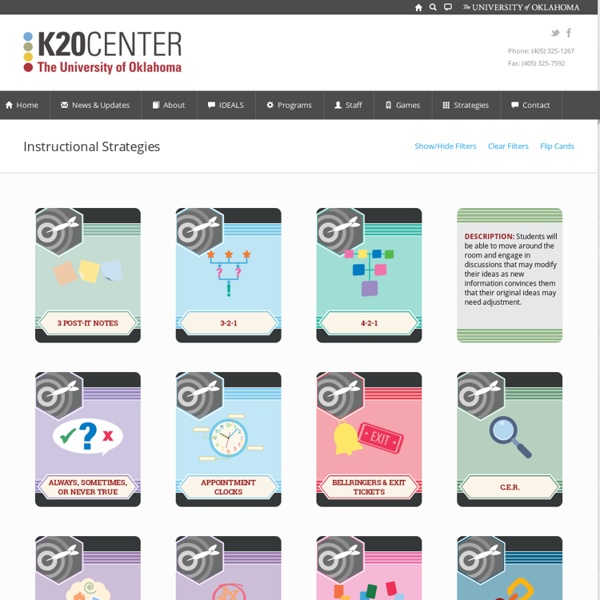



http://k20center.ou.edu/instructional-strategies/
Related: Websites to Check Out • Pedagogy • Active LearningFor Students 2016 2b Students engage in positive, safe, legal and ethical behavior when using technology, including social interactions online or when using networked devices. Positive behaviors Interactions that convey a portrait of the way you want to be perceived and healthy interactions with technology itself, for example, moderating the time online or gaming, ergonomic issues and balancing use of media with daily physical activity. Safe behaviors Interactions that keep you out of harm’s way, for example, knowing the identity of who you are interacting with; how much and what kind information you release online; protecting oneself from scams, phishing schemes and poor purchasing practices (e-commerce theft).
The Thinker Builder: Step In, Step Out: A Strategy for Thinking Deeply About Text You're sitting at your guided reading table, your little group gathered around you, wide-eyed. Or are you the one who's wide-eyed? Sure, you know what you're doing, but maybe right now you're thinking your lesson plan doesn't fit the book like you thought it would. Or that maybe your lesson plan is just lame. Or maybe you don't have a lesson plan and are winging it (oh, come on, we've all been there). "Boy, I could really use a mini-lesson right now," you think.
14 Creative Ways to Engage Students – CELT Fostering creativity can range from simple team-building exercises to complex, open-ended problems that may require a semester to solve. An instructor that presents innovative and challenging prompts will encourage students to work creatively through a problem to a solution. These creative techniques must be done in a supportive course environment with appropriate time allocated for students to discover and develop creative ways to solve a problem. Here are 14 creative ways to engage students in discussions, problem-solving, critical thinking, and more: Assumption Busting
The Best Ways to Use Padlet - Examples from Teachers This afternoon at the ISTE 2016 conference I had a nice meeting with Melanie Broder from Padlet. She told me about some of the things that Padlet is working on developing during the rest of the year. One of things is a community for educators. Universal Design for Learning: An Introduction Universal Design for Learning aims to make modifications in three broad areas that together deliver a programme that will best meet the needs of all learners. In each area the barriers to success are identified and where possible removed or minimised. UDL identifies three essential Neural Networks that combine to produce effective learning, each network as a corresponding place in the learning process. Recognition Networks are the systems that allow us to gather information from our environment and we categorise and make sense of that.
Center for Educational Innovation Choose meaningful activities or questions Explain your rationale to students Develop a facilitation approach Gather and record feedback Choose meaningful activities or questions Visualizing Learning with Infographics: 23 Resources “Numbers have an important story to tell. They rely on you to give them a clear and convincing voice.” – Stephen Few This year get your students to visualize difficult concepts or understand a process by teaching with infographics.
Eight Ways to Use Video With English-Language Learners This blog was co-authored by Katie Hull Sypnieski. This post is excerpted from their new book, The ESL/ELL Teacher's Survival Guide: Ready-to-Use Strategies, Tools, and Activities for Teaching English Language Learners of All Levels. "I like the way you use videos with us -- you get us moving, talking, writing and speaking. The problem is you make us think too much." -- "John," one of our English-Language Learner students